Welcome to Tipping a Suit, where we delve into sustainability topics to envision a world where global challenges are addressed effectively. In this blog article, we will explore the United Nations Sustainable Development Goals (SDGs), also known as the global goals or the 2030 Agenda for Sustainable Development. Adopted in 2015, these goals aim to tackle a wide range of pressing global issues. Join us as we provide an in-depth understanding of the SDGs, their history, principles, and the challenges faced in achieving them by 2030.

The Evolution of the 2030 Agenda for Sustainable Development
The 2030 Agenda for Sustainable Development, adopted universally on September 25th, 2015, garnered support from all 193 United Nations member states. Building upon two foundational processes, namely Agenda 21 and the Millennium Development Goals, this groundbreaking agenda became a comprehensive framework applicable to every country worldwide, regardless of their level of development. Agenda 21, established during the 1992 Rio Earth Summit, focused on environmental priorities, while the Millennium Development Goals concentrated on human development. The convergence of these two processes at the Rio+20 Earth Summit in 2012 paved the way for the 2030 Agenda.
Understanding the Comprehensive Action Plan
The 2030 Agenda for Sustainable Development serves as a comprehensive action plan encompassing three pillars of sustainable development: social, environmental, and economic. The agenda expands upon these pillars by adding the notions of peace and partnership, creating the five P’s: People, Planet, Prosperity, Peace, and Partnership. With 17 goals, 169 targets, and over 230 indicators, the agenda covers a broad spectrum of issues, ranging from eradicating poverty and achieving gender equality to combating climate change and promoting sustainable economies. Although its extensive scope has drawn criticism, it was intentionally designed to present a holistic view of sustainable development.
Fundamental Principles of the 2030 Agenda
Embedded within the 2030 Agenda are four fundamental principles that underpin its implementation. Firstly, the agenda emphasizes integration, recognizing the interconnectedness between different domains of society. Policies cannot be formulated in isolation; their impacts on various sectors must be considered. Secondly, universality ensures that the agenda applies equally to all countries, regardless of their economic standing. It acknowledges that no country has achieved sustainable development and calls for collective action. Thirdly, inclusivity is key to the agenda’s success, as it engages all sectors of society, including NGOs, academia, private enterprises, and governments, to work collectively towards its achievement. Lastly, leaving no one behind stands as a crucial principle, focusing on reaching the most vulnerable populations first, aligning with the lessons learned from the Millennium Development Goals.
The Timeline and Progress Monitoring
The 2030 Agenda operates on a 15-year timeline, commencing in 2015 and concluding in 2030. Every year, the progress of the agenda is reviewed at the High-Level Political Forum held in New York in July. This forum evaluates progress on specific goals and in different countries, identifying gaps, opportunities, and new solutions to expedite implementation. As we enter the decade of action, starting in 2020, the global community faces significant challenges due to setbacks caused by the COVID-19 pandemic. The urgency to make up for lost progress has never been greater, as the 2030 Agenda holds immense importance for our planet, communities, and future generations.
Conclusion
In summary, the United Nations Sustainable Development Goals (SDGs) represent a monumental effort to address global challenges and foster a sustainable future for all. The 2030 Agenda for Sustainable Development, a comprehensive action plan rooted in principles of integration, universality, inclusivity, and leaving no one behind, aims to guide countries in achieving social, environmental, and economic development. Although progress has been impeded by the pandemic, the decade of action provides an opportunity to accelerate efforts and deliver tangible results. Let us embrace this ambitious agenda, working together to build a better world by 2030.
Remember to check our upcoming blog series, where we explore each SDG in-depth and examine the impact of the pandemic on sustainable development. Thank you for reading, and if you have any questions or comments, feel free to leave them below. Together, we can fight for a sustainable future.
